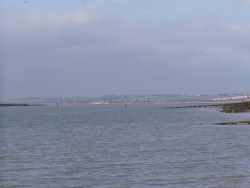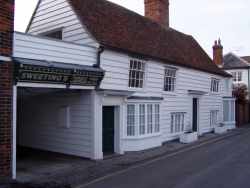Oysters
|
The Rivers Crouch and Blackwater were synonymous with good oysters for many years from the time of the doomsday book until the second world war when for a variety of reasons the oysters were no longer commercially harvested. In 1594 an author called John Norden surveyed many counties in England including Essex. In his report he wrote about Oysters in the following terms .Some of the sea shore of Essex yields the best oysters in England called Walflete Oysters .So called because of a place in the sea although which place is subject of some dispute. By the circumstances that I have observed in my travels I take it to be the shore which lies between St Peters Chapel and Crouch Creeks the breadth of the Dengie Hundred through which on the very shore was erected a wall for the preservation of the land. In 1669 Sir Aston Cockain wrote a short poem in tribute to Essex Oysters The old luxorious Romans vaunts did make of gustful oysters took in Lucrine Lake Your Essex better hath and such perchance as tempted Caeser first to pass thorough France. In 1722 when Daniel Defoe made a similar journey he was also impressed with the oysters. On this shore also are taken the best and nicest, though not the largest, oysters in England; the spot from whence they have their common appellation is a little bank called Woelfleet, scarce to be called an island, in the mouth of the River Crouch, now called Crooksea Water; but the chief place where the said oysters are now had is from Wyvenhoe and the shores adjacent, whither they are brought by the fishermen, who take them at the mouth of that they call Colchester water and about the sand they call the Spits, and carry them up to Wyvenhoe, where they are laid in beds or pits on the shore to feed, as they call it; and then being barrelled up and carried to Colchester, which is but three miles off, they are sent to London by land, and are from thence called Colchester oysters.

Oysters tend to be found in large clusters as Spat ( young Oysters) tend to immediately attach themselves to a larger oyster or oyster shell for reasons of both safety and to improve their breeding chances. With time the oyster banks grow as the higher density of oysters leads to a higher number of fertilised eggs and the larger number of spat. By the 17th century fishermen had identified the large numbers of oysters and began to harvest the crop and over the next hundred years to actually increase the number of oyster beds by catching young oysters and placing them on oyster shells specifically laid down. During autumn after the breeding season the oysters were dredged and the adults sold with the you returned to the oyster beds or pits. By the turn of the century scares about pollution from the sewage outfalls affecting the oysters was followed by virus diseases depleting stocks cut the numbers of Oysters harvested. This was followed by World War 1 and more pollution from ordinance which was dumped in shallow sea water and the increasing pleasure craft usage affected the oyster beds. World war 2 virtually closed the oyster beds and attempts to restart were hampered by an attack of a disease called Bonhamia and more pollution , this time from yachts anti fouling paint and fertiliser washed into the rivers from farmers fields finally put paid to the commercial harvest of oyster beds. Oysters are still found in our rivers although in much smaller numbers and it remains to be seen if nature will be able to repair the damage caused my pollution and disease. River Blackwater Oyster fishery in the Blackwater was operated by Maldon Corporation from 1587 who had a great rivalry with the neighbouring Colchester Corporation who administered the River Colne. Maldon Corporation leased areas of the River to individuals or companies to use for Oyster beds. Companies such as the Fish and Oyster Breeding Company were formed to maximise the harvest. Rivers Crouch and Roach The Crouch and its tributary the Roach were both crammed with oyster beds. Unlike the Blackwater the rights to control the River remained with the Manor of Burnham which were the Fitzwalters followed by the Mildmays.
As with the Blackwater the rights to oyster beds were leased to local men or companies. The account books of Earl Fitzwalter show that in 1730 the sole tenant of the oyster beds was James Camper who paid the Earl �40 per year in rent. By 1739 James Buxton and Robert Hurst are shown as tenants still paying �40 a year in rent. This was a large sum of money in the 1700's which shows the profitability of oysters. By 1780 the Burnham Oyster Company was formed by local Burnham men (John Hawkins, John Sweeting, John Rogers, John Auger and John Gilson) which quickly took control and by leasing the beds from Sir Henry Mildmay and developing the oyster beds. In 1808 rivalry between the two major Oyster centres in Essex came to a head with a raid on the Crouch by the Colchester Oystermen led by Brightlingsea men. The raid was reported in the Times albeit in a slightly humorous vein. Sir Henry Mildmay is equally busy concerning an attack on a large settlement of oysters, in the River Crouch in Essex. This shelly race have been assailed despite the rights of neutrals, by a formidable flotilla or navy, of 35 sail from Brightlingsea , who unprovokedly disturbed the natives in the beds in the most piratical manner, by which numbers perished. Though these sharks were opposed by the Sea Fencibles and by several Magistrates in a boat, they did not desist until they were attacked by the 'Turbulent' sloop, when a great number were seized and every soul taken was sent to a plaice of confinement. Burnham Oyster Company became a major employer in the town with many boats and up to 60 men employed. The Edinburgh Encyclopedia of 1830 provided the following information about the Crouch Oyster Industry.The Wallfleet and Burnham Oysters are the products of the Creeks and pits of the River Crouch. The dredging boats employed are from 14 to 30 or 40 tons. The fitting out of one of 20 tons will require �150. There are from two to four men in each vessel who are paid by shares and the master has a share for the vessel. There has been an increase in boats and of course of men, of more than half in the last 50 years; the number of vessels being now upward of 200 and of men and boys above 500. The quantity of oysters taken in a season is supposed to be above 20,000 bushels. The principal market is London; they are also sent to Hamburg, Bremen, Holland, France and Flanders. Many vessels are also employed in the cod, turbot, herring,mackerel and sprat fisheries.

Oyster theft and damage became a real problem which led to the establishment of a Police Detachment of Inspector Rome and 5 Constables specifically to police the Oyster beds. In addition watchmen were posted on the riverbanks and in dinghies moored in the River.
In 1845 the following people were listed as Oyster Merchants in the Trade Directory John Auger , Senior and Junior - Mary Bowton - John Hawkins- John and Laban Sweeting The wealth generated by the Oysters is shown by the listing of the Auger sisters , Elizabeth Kate Auger, Lavinia Mary Auger, Maria Sweeting Auger and Mary Sweeting Auger as Shareholders in the London Joint Stock Bank in 1852.
Burnham oysters enjoyed a reputation as the finest in the country as the following advertisement that appeared in national press in 1850 shows. Oysters - The Burnham native OYSTERS continue as they have been all season the best sent from London 6 shillings 8shillings 10pence and 10 shillings 6 pence per barrell. A good dish of fish for any number from 6 pence. Post Office Order to John Sweeting , Fish and Oyster Merchant , 159 Cheapside. Very superior Oyster Rooms , Steed's Baldock Bitter, Red's Stout. Many of the large Sweeting family had connections to the River including John Sweetings Fish Shop in Shore Road, Burnham on Crouch pictured below.
|

 Site
of Oyster beds operated by the Ager family at Creeksea
Site
of Oyster beds operated by the Ager family at Creeksea


